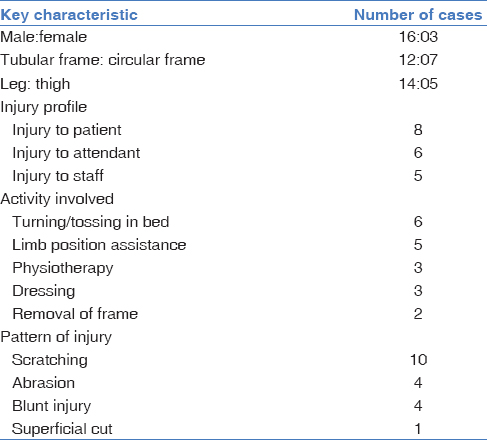Translate this page into:
Penetrating injury by protruding ends of wires or pins of external fixators: An underestimated injury
Address for correspondence: Dr. Ganesh Singh Dharmshaktu, Department of Orthopaedics, Government Medical College, Haldwani - 263 139, Uttarakhand, India. E-mail: drganeshortho@gmail.com
-
Received: ,
Accepted: ,
This article was originally published by Wolters Kluwer - Medknow and was migrated to Scientific Scholar after the change of Publisher.
How to cite this article: Dharmshaktu GS. Penetrating injury by protruding ends of wires or pins of external fixators: An underestimated injury. J Orthop Spine 2020;8:48-9.
Sir,
The orthopedic procedures require placement of internal or external implants for the fixation of various fractures. The external fixator is a versatile apparatus that includes minimal invasive use of pins or wires attached to the bones, which are then externally supported by rods or rings in tubular external fixator and circular (or ring) pattern, respectively.[1] Creative use of fixators is extensively used for various indications as primary or definitive procedure. There are many recognized complications associated with these implant constructs, such as infection of the pin-tract site, loosening, osteomyelitis, delayed, or nonunion.[1,2] One uncommonly encountered and under-recognized complication is injury to patient, attendants, or hospital staff from protruding and jutting wires or pin ends. Extreme care is mandated in every case to ensure that the jutting ends of external pins/wires are cut blunt to adequate size after application of fixators and those ends are covered with some protective cap or wrapped with tape, cloth, etc to decrease their penetrative potential. Similarly, in case of ring fixators, the thin sharp wires are bent inward into the apparatus so that they do not pose penetrative potential. The complex configurations, such as multiplanar or hybrid patterns of these fixators, make them more cumbersome with increased number of pins or its complex design.[3] Despite the precautions, people including attendants or patient himself/herself may get inadvertently injured with these protruding pin ends. Healthcare staff may also get injured during regular dressing or removal of these fixators. The sharp edge of cut ends of Schanz pins or pointed or cut ends of wires of ring fixators easily penetrates gloves and injures the person in manner ranging from mild scratch to a deep incisive wound. We, in this context, tried to note the incidence and pattern of these under-reported injuries in a tertiary care center. Key finding of our experience with some of these consecutive injuries during 20-month period from December 2016 to August 2018 is described in Table 1. The majority of injuries involved male patients due to the fact that male patients dominated the cases with fixators applied. Leg fixators were commonly used while tubular-type fixators were used more often than circular frames. The key injury patterns emanating from injuries related to protruded hardware noted were scratching, abrasion, and blunt superficial injury in most cases, while only one case has deep incisive wound that required daily dressings and prolonged the length of stay. Most of the injuries were experienced by patient himself/herself as the external apparatus was cumbersome and required time to adjust and adapt. As the instructions about management of pins and the apparatus are explained in ward rounds, the postoperative night was the time most of these inadvertent injuries took place. The injuries were also noted during physiotherapy or during removal due to manual loosening of bolts under constrained spaces between the apparatus and limb, thereby increasing the chances of injury. Our short observation about these silent injuries advocates due acknowledgment of seemingly smaller but largely avoidable incidents. Proper educative efforts are warranted to ensure their incidents, and magnitude remains minimal.

Financial support and sponsorship
Nil.
Conflicts of interest
There are no conflicts of interest.
References
- Principles of External Fixation. In: Rockwood and Wilkins' Fractures in Adults (8th ed. (International)). Philadelphia, PA: Wolter Kluwer Health; 2015. p. :227-305.
- [Google Scholar]
- Complications of limb lengthening. A learning curve. Clin Orthop Relat Res. 1994;301:10-8.
- [CrossRef] [Google Scholar]
- Primary external fixation with consecutive procedural modification in polytrauma. Unfallchirurg. 2002;105:315-21.
- [CrossRef] [PubMed] [Google Scholar]





